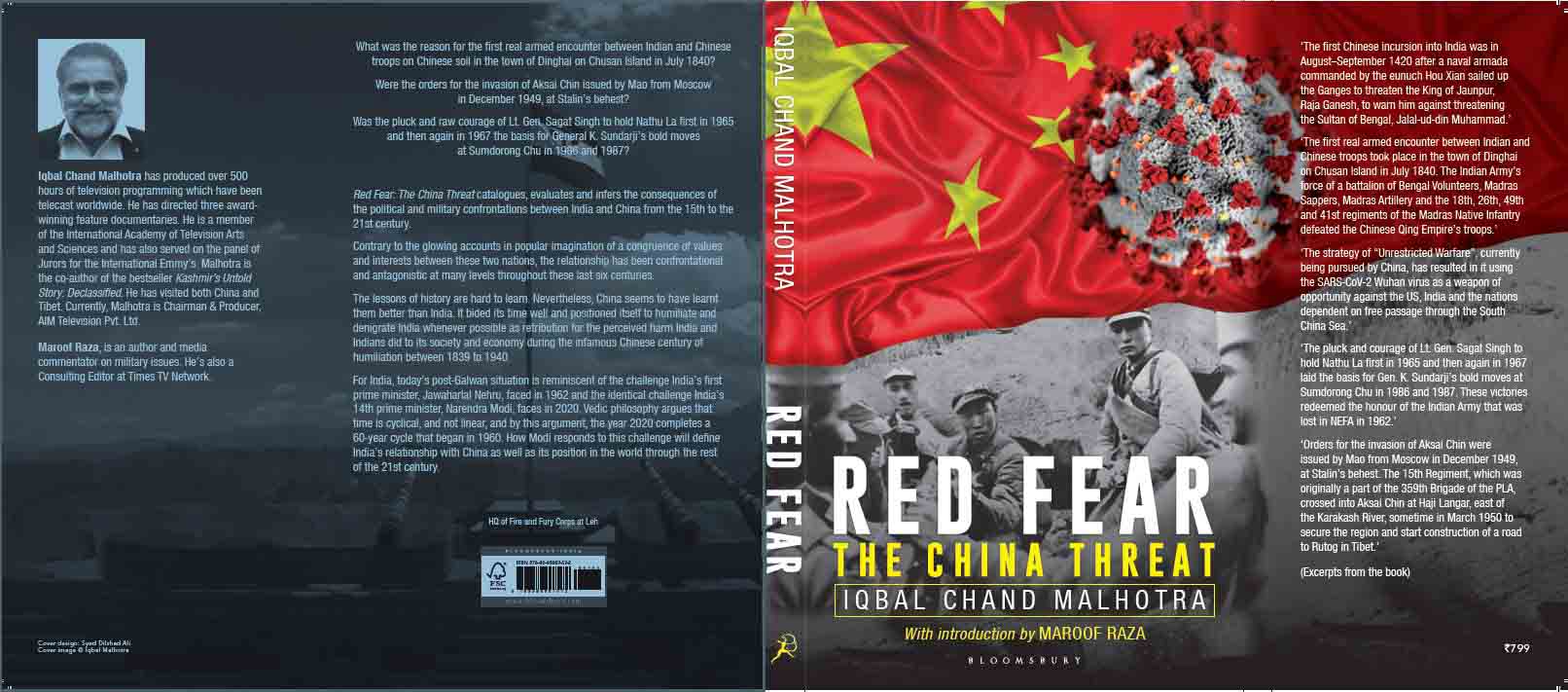Book Title: RED FEAR: The China Threat
Author: Iqbal Chand Malhotra
Publisher: Bloomsbury
Pages: 419 in hard cover
Price: Rs. 799/-
Having read and reviewed many books on China published since the Wuhan Virus ‘outbreak’ and then reading this one and chatting with the author about it even as this author finishes writing his own book about China, what emerges is that it would not be wrong to classify the Chinese Communist Party as the greatest threat to mankind.
Red Fear-the China threat catalogues, evaluates and infers the consequences of the political and military confrontations between India and China from the 15th century to the 21st century. Contrary to the diplomatese about a congruence of values and interests between these two nations, the relationship has been confrontational and antagonistic at many levels throughout the span of these last six centuries.
Having learnt the lessons of history better than India, China bided its time well and positioned itself to humiliate and denigrate India whenever possible as retribution for the perceived harm India and Indians did to its society and economy during the infamous Chinese century of humiliation between 1839 to 1940.
The 2020 Galwan situation is reminiscent of the challenge India’s first Prime Minister Jawaharlal Nehru faced in 1962 and the identical challenge India’s fourteenth Prime Minister Narendra Modi faces in 2020. Vedic philosophy argues that time is cyclical not linear and by this argument the year 2020 completes a sixty-year cycle that began in 1960. How Modi responds to this challenge will define India’s relationship with China as well as its position in the world through the rest of the 21st century.
The book is unique as it packs some very important, significant, eye-opening and fascinating events.
The first Chinese incursion into India was in Septmber 1420 when a naval armada commanded by the eunuch Admiral Hou Xian sailed up the Ganges to threaten the King of Jaunpur, Raja Ganesh.
Did Indian defeating the Chinese Qing Empire’s troops in 1840 and crushing the Boxer Rebellion in 1900 deeply prejudice the first-generation leadership of the Communist Party of China and influence their actions towards India after they assumed power in 1949 and how the Indian Army kept China subdued between 1839 and 1939.
What role did the three highly classified British seismic and acoustic nuclear monitoring stations called ‘Stowage’, ‘Tagday’ and ‘Beaver’ located in the Gilgit Agency by the banks of the Indus river close to the Hindu Kush range play in the de facto partition of the State of Jammu and Kashmir in October 1947? What role did they play in the transfer of the Shaksgam Valley by Pakistan to China?
Were the orders for the invasion of Aksai Chin issued by Mao from Moscow in December 1949, at Stalin’s behest? The PLA’s 15th Regiment which was originally a part of the 359th Brigade of the PLA crossed into Aksai Chin at Haji Langar east of the Karakash River, sometime in March 1950 to secure the region and start construction of a road to Rutog in Tibet.
On 14 October, 1962 in Moscow, did Soviet leader Khrushchev assure outgoing Chinese ambassador Liu Xiao, of Soviet support for a Chinese invasion of India? Khrushchev confided in Liu Xiao that he had been secretly installing nuclear missiles in Cuba and he hoped for Mao’s support in return. Both the Chinese invasion of India and the Cuban missile crisis kicked off on 20 October, 1962.
Was Lt. Gen. Sagat Singh’s move to hold Nathu La first in 1965 and then again in 1967 the basis for Gen. K. Sunderji’s bold moves at Sumdorong Chu in 1986 and 1987? These victories redeemed the honour of the Indian Army that was lost in NEFA in 1962.
Is China using the Wuhan virus as a weapon of opportunity against the US, India and the nations dependent on free passage through the South China Sea? Is this weapon of opportunity a part of the Chinese strategy of unrestricted warfare?
The book also reveals that the partnership that the UK had with its Indian colony in subjugating and destroying the Qing Empire and later enslaving over a quarter of its male population to the addiction of opium created an unresolved angst within the psyche of the Communist Chinese leadership that continues to manifest itself in China’s belligerence and aggressive behaviour.
How Nehru’s ignorance/naivete/warped ideas/ contentious philosophy made him compromise India’s sovereign territorial and extra territorial interests.
The book encompasses the sweep of history in its revelation of hitherto classified truths so that impacted thinkers and leaders develop strategies to keep their nations free from dominance by a single emerging hegemon.
Another major revelation in the book compulsions behind China’s hunt for water and the web of deceit and lie” behind China’s land grab and water theft in the Himalayas and Karakoram mountain ranges since 1950.
This is Iqbal Malhotra’s second book after his bestseller Kashmir’s Untold Story: Declassified which he co-authored in 2019 with Maroof Raza, who has written the introduction in this book. A member of the International Academy of Television Arts and Sciences, Malhotra, who served on the panel of jurors for the Emmys, is currently the chairman and producer at AIM Television Pvt. Ltd. and directed three award-winning feature documentaries.
The book is a must read for China watchers.
The reviewer, a strategic analyst and former spokesperson, Defence Ministry and Indian Army, can be contacted at wordsword02@gmail.com.

The writer is editor WordSword Features. He is also a strategic analyst and former spokesperson, Defence Ministry and Indian Army, and can be contacted at wordsword02@gmail.











